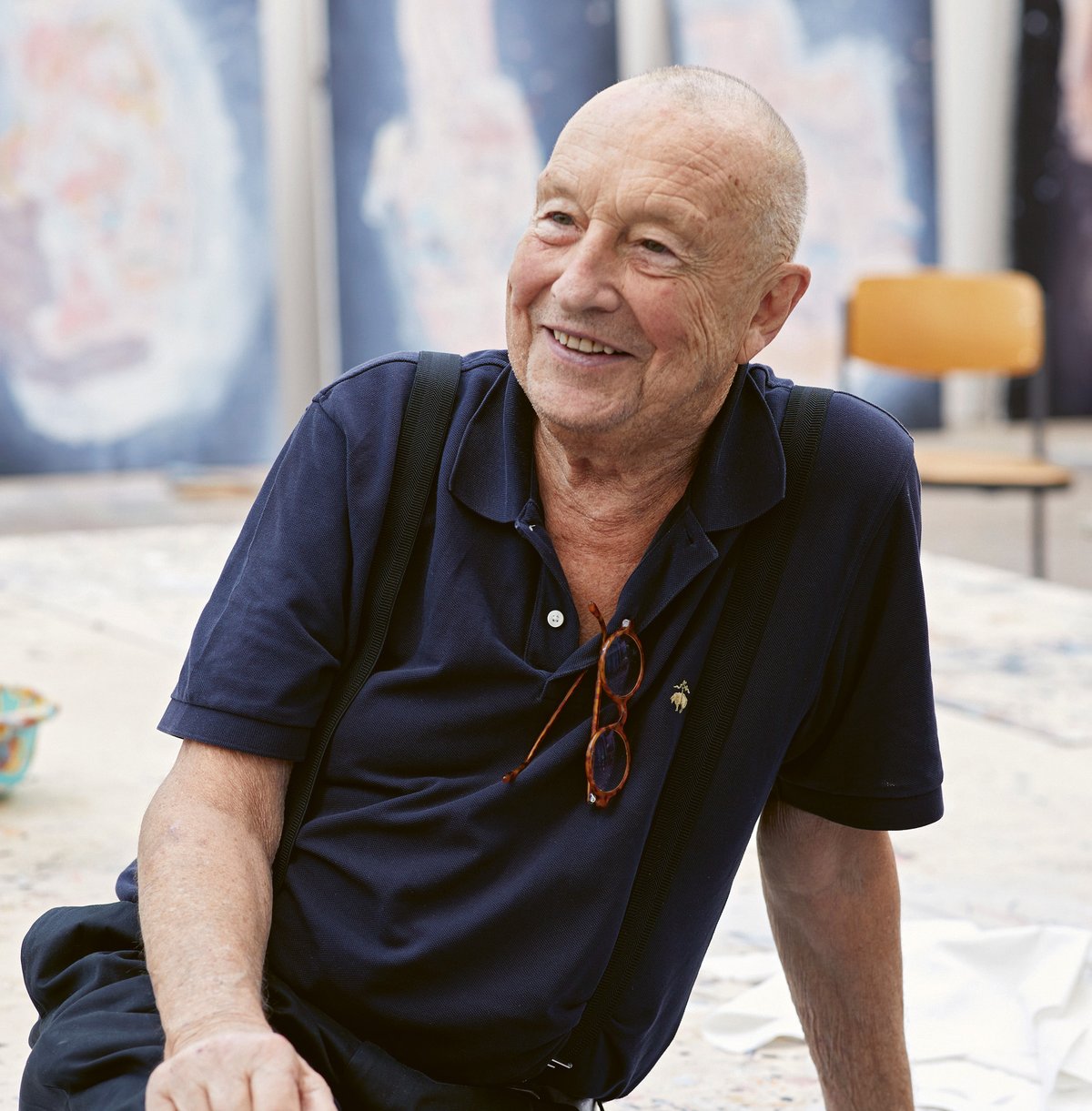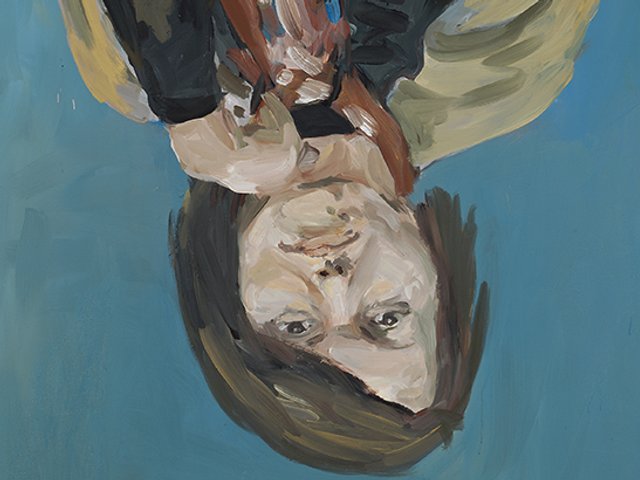Whether by turning his paintings upside down or with his widely reported comments that women are not good painters, Georg Baselitz, one of the most influential artists of his generation, has never been afraid to provoke. Now 85, he is exhibiting sculptures and sculpture drawings at the Serpentine. Here he talks about the German tradition of sculpting in wood, why it is important for artists to be provocative, and the “sad” German art scene.
The Art Newspaper: One of the sculptures on display at the Serpentine, Zero Dom (2021), is 9m high. Can you tell us how this work came about?
Georg Baselitz: All my work and my sculptures generally have a biographical or autobiographical background. Nothing I have made so far is conceivable without my background. Either the work itself or at least the title indicates that. Zero Dom, for example, is not a glimpse into the future, but rather describes what we perceive as the German past: in short, a burnt-down building. Zero Dom was initially a small wood sculpture comprising individual women’s legs about 3m high. A black patinated version cast in bronze followed. In 2018, I designed the stage set for Wagner’s opera Parsifal in Munich. The sculpture became part of the set, in an enlarged form. The Holy Grail was hidden inside it. Then I decided to make a 9m-high bronze casting out of it, which was first placed in front of the Institut de France when I was named a member of the Académie des Beaux-Arts.
Your use of wood is rather unusual today, but it reflects a strong German tradition; we think of Tilman Riemenschneider, for example. Do you see yourself as a German artist in this tradition, or is your use of wood also inspired by other cultures?
German tradition is absolutely right. Tradition in general is very important for me. In Germany, we don’t have a significant tradition made visible by archaeological finds—as, for example, in the Mediterranean region. Since the 14th century, there have been large, decorative stone sculptures in our places of worship but, equally, very important wooden sculptures—for example, by Riemenschneider. And this continues until Ernst Ludwig Kirchner. My first attempt was a wooden sculpture in 1980 for the Venice Biennale and I stuck with it.
Ten wooden sculptures carved from individual tree trunks featured in the show have never been exhibited before. The Serpentine’s press release states that they relate to your personal life, including a childhood memory. Do you find that, with age, your personal history has become more important to your art, or is this childhood memoir showing three girls from a Nazi youth group also a political statement?
When I work, I always think about my past. My background was very ordinary and rural in a place far off the beaten track. When I make a sculpture, like BDM Group (2012), the goal is not a priority; it is more like a poetry that slowly unfolds. Again, the title clearly refers to my origins. The kinds of statements on daily politics that we see a lot in contemporary art are not my thing.

In this lifesize figure carved from wood, Louise Fuller (2013), Baselitz pays homage to the pioneer of modern dance Photo: Jochen Littkemann; © Georg Baselitz
What can you tell us about the drawings on show and the production method?
I think the sculpture drawings are different from my other drawings. Sculpture drawings are important observations for working in three dimensions or on a wooden trunk whose original volume you reduce, by cutting and chopping and so on. Without the drawings, mishaps and misfortunes would be more frequent. I have been making such drawings since 1980 when I started sculpting. But there are none of these preparatory drawings by me before that.
Tracey Emin has said that your provocative approach to your art “kept the gateways open for artists like me”. Who are the art-world provocateurs of the next generation you most admire?
Tracey Emin said exactly the right thing. I have found in art history that when an artist, whether male or female, has success early in their career, it is usually with a provocative work. Most first works confirm that—whether by Tracey Emin or Paula Modersohn-Becker, by Cézanne, Frida Kahlo or Picasso. But being provocative just to provoke is difficult. I don’t think it works, or only for a short time. As far as the next generation is concerned, I still find the British art that surprised me when it first appeared—thanks to Charles Saatchi’s willingness to take risks—very interesting.
You have complained in the past that Berlin museums are not sufficiently interested in German art. Do you think that has changed? Will your work be shown in the new Berlin Modern art museum and, if so, which ones?
Just compare Berlin’s Nationalgalerie with its London equivalents. Berlin has hardly any contemporary art. After they tried to repair the past by recovering “degenerate” art or other works, not much new has happened in German museums, especially in Berlin—not to mention the low visitor numbers compared to other metropolises.
What do you think of the plans for the new museum, which is currently under construction?
I think any new museum in Berlin is superfluous.
What do you think are the most interesting developments in the art market today?
I have not concerned myself with digital art at all. For me, there is no such thing. I work with paper and pencil, with paint and canvas and with wood. And all the works by other artists that have drawn my attention use similar materials.
What worries you most about Germany and Europe today?
People abroad can’t imagine that in Germany, there is no cultural scene comparable to that in the UK, the US or France. It’s a regrettable, very sad state of affairs. But since there is a well-functioning international art market, German artists can make a living independently of Germany.
You are known for your ability to provoke not only with your art but also with your words—for example, with a statement in Der Spiegel in 2013 that women are not good at painting. Since then, you have expressed your admiration for many female artists. Museums are now making an effort to show more works by women. Do you welcome this attempt to redress the balance, or do you think it is a distortion?
There are only new artists and their first works, and of course that has nothing to do with gender or age, but everything to do with what appears on paper or on canvas.
The Guardian wrote last year that you are experiencing a “fiery and ruthlessly expressive late flowering” in your 80s. Do you think that’s true?
If what they say is true, then I’m very happy about that. Even if you leave out the “fiery” and “expressive”—and even “flowering”—it is still a fact that I have not given up, and that I continue despite an almost complete absence of pressure—less depressive, but even more dystopian.
Do you still work in your studio every day? Can you describe a typical working day?
I try to work every day, for a very limited amount of time. My physical condition is not the best. I use various aids such as walkers, carts, walking canes, chairs, extended brushes, extended palette knives and quicker decisions. So far, that’s working well.
• Georg Baselitz: Sculptures 2011-2015, Serpentine Galleries, until 7 January 2024



